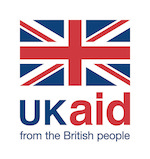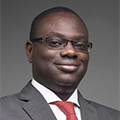In 2019, I travelled to Uganda to visit refugee camps in the northern part of the country to get a first-hand experience understanding how mobile technology could help these displaced communities improve their lives. There I met Joseph (not his real name). Joseph is in his mid-thirties and runs a rather successful mobile phone shop in the refugee camp. The group I was walking with through the camp was intrigued by the brisk business he was conducting, and when we stopped to speak with him, we ended up having the chance to hear his story.
Joseph had come from South Sudan a few years ago. He used to run a shop there, but had to leave when things got really bad. Initially, after arriving at the camp, he had hopes of returning. But the more he heard stories of the death of people who returned, he decided to settle down and make a life at the camp. Today, he is a successful mobile money agent. He also sells phone accessories and provides mobile phone battery charging services. Though he longs to go home one day, he is happy at the camp, and his business is ten times bigger than what he had in South Sudan. So for now, Joseph believes he has a bright future.
Joseph’s story informed and continues to shape how we design our projects at the GSMA Mobile for Humanitarian Innovation programme (M4H). The partnerships established under the programme aim to bring mobile operators and humanitarian organisations together to demonstrate how mobile technology is being used to provide sustainable solutions to humanitarian challenges. We have categorised our partnership projects into four areas that we believe would help people like Joseph and many others in humanitarian situations across the world build empowered and resilient lives.
The first category is about strengthening foundations. This includes training and educational programs. In a partnership with Grameen Foundation and MTN Uganda, we are training and setting up women in the Bidi Bidi refugee camp as mobile money agents, just like Joseph. Through a newly created digital and financial literacy training tool, we are building their capacity to run sustainable businesses. The income they will earn will help build their resilience and the knowledge and skills they have gained will offer them opportunities for the future.
The second category is about creating new types of partnerships which can identify, design and implement solutions. To create the environment for Joseph to thrive, many stakeholders would have had to come together to share ideas and provide complementary solutions. We have formed four consortia in four countries, bringing various local stakeholders together with mobile operators and humanitarian organisations to enhance the coordination of humanitarian preparedness and response. The KUHI consortium in Rwanda brings together two mobile operators, four humanitarian organisations and a fintech to identify key areas they collectively believe will best help to improve the lives of both refugees and the host community.
The third category focuses on creating new technology solutions. Mobile technology is key to Joseph’s business and plays an important role in providing solutions that both refugees and humanitarian organisations rely on. In Somaliland, our partnership with CARE and Telesom uses mobile voice identification technology to verify households as they receive their humanitarian cash payments. In Rwanda, we are working with World Vision International to digitize village savings and loans associations (VSLAs), making the process of group savings more efficient, less time consuming and safe.
Last but not least, is our focus on building a digital ecosystem. This is an environment where people can use digital resources to meet their daily needs. In Uganda, we are partnering with Alight (formerly the American Refugee Committee) to provide solar powered charging stations for refugees. In many ways all the other three categories contribute to this last one – creating an environment where people in need of humanitarian assistance can receive digital payments safely and transact digitally. When agents are trained and skilled to serve people just as we have done with our Humanitarian Code of Conduct training in Rwanda, and where the technology is used to provide much needed services to those in need, we move closer to creating that digital ecosystem that would enable people to thrive.
Joseph mentioned some key challenges that he faces in his business. Though the number of people at the camp owning a phone is growing steadily, there are still many people, especially women, who don’t own their own mobile phone. His business is on the main road in the camp, which means those who live further away on the outskirts of the camp are not served as agent numbers are limited. They have to travel to the main commercial centre of the camp to access mobile money services. Connectivity is less reliable in certain parts of the camp. Financial and digital education is low making it difficult for people to make full use of the mobile technology available to them. The GSMA reports The Digital Lives of Refugees and Mobile Money Enabled Cash Assistance – User Journeys in Burundi, describe the experiences and challenges of people accessing digital humanitarian assistance.
As we develop new projects and partnerships, we continue to learn from the many people–like Joseph–who have already been positively impacted by mobile technology. Their experiences serve as a guide and as inspiration as we accelerate the impact and delivery of digital humanitarian assistance.



